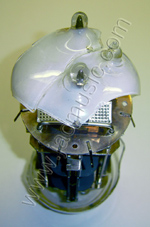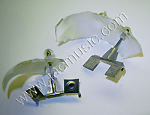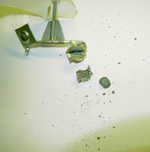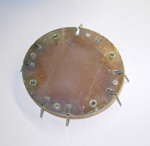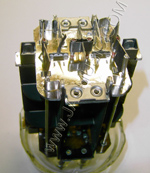Portrait of a Tube
6C33
( 6C33B
Name of this tube
Letters in Russian are different.
Russian: 6C33C or 6C33C-B for special Version.
Western: 6S33S or 6S33S-V for special version
Original use
This tube was intended as a series regulator, in tube power supply. It became often used by the Soviet Union in the power supply of a jet fighter, the Russian MiG jets, such as MiG-25. Due to the separate heaters, one system could serve as a spare in case of a failure, without having to replace the tube immediately. Such solutions can be made with a relay. Thus greatly increasing the reliability of one bulb. However the systems are electrically connected, so it has to be used as one triode.
Price history
I remember in the 1980's this tube was forbidden to export, and then at some moment a German company, got hand of first stocks, and re-stamped them with their own branding and part number "WT500" selling them as "the best tubes ever made" with a lot if powerful talk in the HiFi magazines, about "their" discovery. Price was a 500 Deutschmark, which at the time would pay to fill the gas tank of your car 10 times. Then after not too long time, Russian 6S33S (6S33S-V) began to come to Europe, and we all could play with those beasts for reasonable prices.
Then around 2010, the Russians began dumping their 6C33C (6C33C-B) stocks, and there were times you could buy them in Russia at 500 pcs for 2500 Euro. These days are long gone now. The quantity dumping has stopped, stocks are emptied. Prices will find their old levels again. So you can say, what is today's price of a wonderful, powerful triode, of great appearance, and why should 6S33S (or special 6S33S-V) not have such a price?
Nuclear attack plans by the Soviets
In the period from 1960 to 1989, the Soviet Union was preparing for a nuclear attack. From technical remains such as this vacuum tube, you can see how close the world was to a nuclear disaster. We thank it to Mikhail Gorbachev, awarded the Nobel Piece price, this did not happen. This man was of a caliber and overall wisdom, looking at the world as our a common possessed planet. (The word planet for this, is his) . A view, so far fully absent with Russian politicians, but he payed a high price for it, by later repressions against him, he was even put in prison for some time, but they dropped charges. He was rehabilitated, and a memory center to his work and person exists.
What is an EMP?
When a nuclear bomb explodes, electromagnetic waves of all frequencies are produced, with absurd intensity, at the moment of explosion. We call this the Electro Magnetic Pulse (EMP), which is just like a series of Radio waves. A normal radio transmitter produces only one frequency, and as we all know such a transmitted signal will produce an electric signal in an antenna, even at the other side of the globe. Whereas EMP produces all wavelengths at the same time, and is doing so at such absurd energy, not just a radio signal is produced in all of those antennas, and other metal objects, but a very high voltage is generated. This will destroy every semiconductor in very wide range.
There are funny videos of people holding a neon near a 5 Watt small transmitter, and it lights up. Mind you that needs 90Volt to ignite a neon lamp. Similar, that 90V is able to damage semiconductors, though current is low, and the semiconductors likely survive, protecting themself by conductive effects, either in forward direction, or by a Zener (avalanche) effect in reverse direction. But hold your Iphone near to a 500 Watt radio transmitter antenna, and I guarantee you it is damaged. So how about a 100 Mega Watt impulse? In what range will that kill all mobile phones, and computers, cars, radios, electronic systems and everything?
Imagine the extreme effects of this. It would leave the bombed areas of Europe in the pre-electricity time, but without electricity, NOTHING works. No tap water, no heating, no food, no cars, no phone. This scenario was not a possibility. The Russians always had the strategy of loud threats,repeated all over, to scare the media, and the people. While secretly working on devastating plans of another kind.
Specific EMP bombs (Cobalt type) have the main intention to destroy all electronic systems, and leaves most of the rest intact. Any electron tube near by will also stop working during an EMP too, but the tubes itself are not damaged by high voltage, and will recover once the EML is s gone. However, all semi conductor communication systems of the enemy are dead immediately. Only your tube amplifier will be undamaged.
Here is the story which really happened
The Americans were extremely surprised when a Russian MIG 25 "Foxbat" had to make an emergency landing in Japan, in 1976. The pilot, Lieutenant Belenko, applied for Asylum, and it was the first time the allied forces got their hands on a complete, working MIG. They found it was fully equipped with tubes only, and the body of the airplane was of much too thick metal. They had a good laugh about the primitive Russian technology. Then, later on, this incident was the MAJOR element that gave extreme acceleration to the nuclear cold war. The Russians had their own semiconductors which were not bad at all. The fact that all MIGs were fully tube equipped, was an important Russian secret that now leaked, and it shock-waved through political system of the West. So, the Russians were not preparing for nuclear DEFENCE as they used to tell. They were preparing for an ATTACK. These MIGs were idea to deliver those tactical nuclear bombs, of EMP type.
After the communism got bankrupt, It took until 1995 until the Russians officially let go of their "cold war" tube stocks. After that (and not before) the 6S33S was available in quantities. Same as several other Russian tubes of the period, like 6N30P (6H30П). The small brother of 6C33C is 6S19P (6C19П), which has the size of an EL84. These are amazing tubes, made to do a reliable job during those critical EMP moments, and quality and technology of those is the best as ever could be produced. So you won't find that in any datasheet, but yes they are EMP proof.
I took apart a 6S33S, to see what's inside. Most of the quality you can't see with the eye, such as chemical things, and special treatment of the materials. What is visible at first sight, is the extreme ruggedness, and all mechanical parts are made from very hard, and also solid metal. That is amazing. The tube was so hard to take apart. The cutter tool I used, I had to throw it away afterwards. The anodes are 1 mm (!) thick metal, and not just nickel which would be normal. It is some hard metal, which I could not cut easily. The bulb is high temperature hard glass, even the pins are not normal metal. Everything, really *EVERYTHING* is made to endure MUCH higher stress and temperature, as would be needed only as a series regulator
THE PINS OF 6S33S.
This may be worth some extra text. There is great dissatisfaction with some amplifiers, where powerful vacuum tube burns down the socket. So we must see if that is unintended use of the socket, of the tube, or both. The tube bottom is hard glass, which can be seen by the pins developing a white color where the glass melts on them. The hard glass is do deal with the extreme heat, this doesn't crack, but most of all hard glass is used when tubes get extremely hot. Hard glass doesn't become as conductive as soft glass at great heat.
Users often complain the pins get corroded over time, and cause bad contacts. People try to scrape that off, but it is too hard substance. Sometimes there is a layer on there, which I heard somebody on a website call 'white shit". Nice word for it. Recently a customer of mine complained about broken off pins. I took a defective 6C33C, and tried to break off the pins. That worked indeed, but they were quite strong, until they broke off with a glass-like sound. They way they broke off puzzled me, and I suspect these are not made of normal metal, but of so called amorphous material.
What is amorphous material? You can melt glass and steel together, in every desired ratio. The less steel, the more the material begins to behave like glass, and of course, the less conductive it gets. I know from amorphous transformer cores, the ratio is 1.1 there. That looks like metal, and behaves like hard metal, but also it can splitter like glass when are not careful.
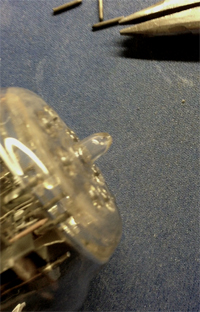 To me, those pins look like amorphous material (That is in fact a mixture of glass and metal) The advantage of amorphous material is, it will not crystallize, like any metal does, and it needs no explanation this attaches much better to glass, than pure metal. Also thermal expansion can be more closer to glass, than metal only. With the extreme heat of this tube bottom this can become important. I do not know for sure if that is amorphous, but it breaks like glass, and gives a crackling sound like glass too. Click on the picture, or here to see a video.
To me, those pins look like amorphous material (That is in fact a mixture of glass and metal) The advantage of amorphous material is, it will not crystallize, like any metal does, and it needs no explanation this attaches much better to glass, than pure metal. Also thermal expansion can be more closer to glass, than metal only. With the extreme heat of this tube bottom this can become important. I do not know for sure if that is amorphous, but it breaks like glass, and gives a crackling sound like glass too. Click on the picture, or here to see a video.
Today's use of 6C33S (6C33B), and why so many 'so called' bad 6C33S (6C33B) burn down in 'good' amplifiers.
Now to begin with, let me say that building a tube like 6S33S (6S33S-V) is sure NOT 100 times more difficult than building an OTL amplifier. That would perhaps apply for a 6SN7, or a 12AT7. But with this power triode as audio it is 1000 times more difficult.
Just suppose you are an OTL amplifier designer, and you have every time SAME difficulties with this vacuum tube, failing in the amplifier, the same way. So they seem to have a quality issue, causing them to become instable, and then burn to death. Suppose the factory would still exist, and you bring a amplifier with malfunctioning tubes to the engineers of the 6C33C. In the factory in Russia,.you put the amplifier on their table, and complain about the tubes which always tend to fail after some time. If a tube fails, you put it in another socket, and /"the problem will follow the tube"./ That method, you tell them, is known to every good engineer, and it proves with certainty, the tubes have a problem. In addition, the amplifier has proven to be good, because you build it since 25 years like this, and it always worked well. One of the engineers ask for data on your tube tester, before taking them in service, but you say you don't have a tube tester, and it is not needed. Just Imagine the look on their faces, the things they will say, and how they try to help you. They will ask for a schematic, but they you say, you will not give that because it is company secret, and they should not try to focus the attention away from the tubes itself.
You may think the above imagination is absurd, but reality is even more absurd, to the next higher level. In reality, myself as a tube dealer, I get the above situation presented by phone only. When I ask for the type of the amplifier, they pronounce the brand name with deep respect. But when ask for the schematic, they say if I want to know about such things, I have to look that up in the internet myself. THIS is the level 6C33C is treated on. Now, of course users don't mean this bad, I understand that. But it is still what is happening. They real problem is with the following, addressed to designers
PLEASE READ THE datasheets. You cannot ignore them, just because they are in Russian. Then without reading it, it may go wrong. Consider blaming the amplifier and yourself, when such robust tubes for MIG airplanes were good when you received them, but do not work well in your amplifier.
Actually I have seen such blatant ignorance with some 6C33S (6C33B) amplifier builders, that I find it valid to point this out clearly. So this is not addressed to good electronic engineers. Actually I find many DIY are much more careful not to damage anything.
The MOST IMPORTANT THING you should know about 6S33S, when designing amplifiers
Every tube has an intended use. It is important to accept, if not used as intended, you need to be sure nothing goes wrong because of that. Like 6C33S (6C33B) is definitely NOT intended for fixed bias.
The most common mistake with data sheets, is not misunderstanding them, but not reading them at all. The second common mistake is with the empty boxes of the data sheet, where manufacturers write nothing inside. Like typical values are given, but limiting values are not given. With that, you are taking a risk, and the crying is very loud when things don't work out. It cannot be repeated often enough how important it is to read a datasheet in the first place, and most of all read it when you use a tube not as intended as written in there.
In that relation, we clearly must say this:
INTENDED USE: 6S33S = POWER SUPPLY regulator. So bias is by definition then in a closed loop. So drift, and leakage are no issue, as long as the feedback loop can deal with it. It was intended by the makers, that you do this.
This was NOT Intended by the makers of 6S33S: Circuit with fixed bias, and the circuit is such, that drift and leakage can burn down the tube.
6C33S (6C33B) is intended as a forward conductor, in a closed loop, regulated power supply. This means, the bias of the tube is electronically regulated by the feedback loop. Maximum data of the tube is specified with THIS intended use (the green text) in mind.
Now here comes the HiFi use, it is usually OTL. The efficiency of an OTL circuit is very low. So what will the designer do? He uses the highest possible dissipation, to get the power out of the tube. To eliminate risk, they use only 90% of maximum dissipation. I don't know who invented this first, but many think if you use a device at 90% of maximum, it will last a very long time.
The circuit designer has the option to choose between auto bias and adjustable bias. Both have risks and problems. An auto bias circuit works so well because the bias is determined by a closed loop, where the gain of the tube is the 'loop gain'. The higher the gain of a tube, the better auto bias is working. So what is the gain of 6C33S (6C33B)? It is an incredible low 2...3x depending on the working point. So auto bias is not working well, and the tube can easily drift away. Of course they find that out, and some use hand adjustable bias. This is probably better, but the whole concept works by the merit of stay safely below maximum. And safety means not 10%, and sure not when you use a product in an unintended way. Conclusion: With the above considerations in mind, perhaps you understand better now, why 6C33S (6C33B) fails so often with bias problems in OTL amplifiers. The problem CAN be the tube indeed. So the Russians did a bad job, and let many bad tubes pass, and nothing is perfect. But saying this, nothing is perfect, the problem can also be the amplifier. So to understand this situation we have two choices:
- Either all MIG air planes were flying around with potentially bad tubes
- Or.... many good vacuum tubes are potentially destroyed by bad designed amplifiers.
And I think I already know the answer. FORGET ABOUT Option 1.
When dealing with 6S33S (6S33S-V) tubes we see often, how good tubes destroyed by bad amplifiers. Do not think you can recognise bad internal design by a bad external design. Also, vice versa do no expect a good internal design us guaranteed by a good brand name on the outside. Often the relation is reversed! If a so called "great" brands only run on selected tubes, this means you have problems coming your way. These amplifier seem to need "better" tubes. The selection however is only needed because this amplifier would simply destroy perfectly good tubes otherwise. Of course the amplifier designer would call such tubes "bad" but this is only partially true. These tubes were good before they were put in the amplifier. They would become bad afterwards. So in a way the amplifier designer is right, but only in this order.
